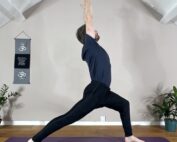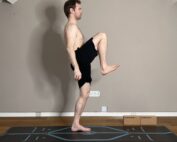
Try These 3 Headstand Variations (Sirsasana)
Hi there! I’m Dav Jones, sharing my yoga practice, my teaching and how it’s helped my life is my greatest passion. Welcome to the upside-down world of headstands. In this blog, we’ll uncover what headstands are, explore various exciting headstand variations, and delve into the incredible benefits they offer. I’ll also share essential tips to help you practise safely and effectively. Whether you’re new to inversions or looking to refine your technique, this guide is here to add insight and elevate your yoga practice. Let’s get started and turn our world upside down together.
What is a Headstand (Sirsasana)?
Sirsasana, or Headstand, is a challenging inverted yoga posture that involves balancing on the head and arms while the body is inverted. This pose is revered in the yoga community for its ability to stimulate the mind and strengthen the body. When performed correctly, Sirsasana can help improve balance, increase focus, and promote blood circulation in the upper body, including the brain, which can lead to improved cognitive function.
Basics of Headstand (Sirsasana)
- Sanskrit Name: Sirsasana
- Pronunciation: sir-sah-SAH-nah
- English Name: Headstand
- Meaning: Sirsasana breaks down into two Sanskrit words: “Sirs,” meaning head, and “Asana,” meaning posture or pose. Therefore, it translates literally to “Head Pose.”
Benefits of Headstand (Sirsasana)
- Improves Circulation: Headstand reverses blood flow in the body, enhancing circulation to the brain and boosting cognitive function.
- Increases Core Strength: Regular practice strengthens the core muscles, which improves stability and balance.
- Reduces Stress: The inversion has a calming effect on the brain, helping to relieve stress and mild anxiety.
- Enhances Focus: Maintaining a headstand demands concentration, which can improve overall focus and mental clarity.
- Stimulates Lymphatic System: Inversions help facilitate the drainage of lymphatic fluids, boosting the immune system and aiding in detoxification.
These benefits make the headstand a valuable pose for both physical and mental health.
3 Headstand Variations to Explore
Headstand (Sirsasana) offers several variations that cater to different levels of yoga practitioners, from beginners to advanced. These variations not only add interest to your practice but also help you build strength and flexibility in various areas. Here are 3 of the most common Headstand variations:
1. Forearm Headstand (Salamba Sirsasana I)
Level: Intermediate
The Forearm Headstand, or Salamba Sirsasana I, is a fundamental inversion in yoga, often considered a stepping stone to more advanced headstand variations. This posture utilises a stable triangular base formed by the forearms and head to support the body in an inverted position.

Steps of Forearm Headstand (Salamba Sirsasana I)
- Base Formation: Sit on your heels, clasp your hands together, and place your forearms on the mat, forming a triangle.
- Head Placement: Lower the crown of your head to the mat, cradling it with your clasped hands.
- Lift Your Hips: Tuck your toes and straighten your legs. Walk your feet closer toward the body, feeling the hips stack on top of the shoulders.
- Raising the Legs: Walk your feet towards your head, and carefully lift your legs off the ground bringing them into a tuck position first, then slowly extending them straight up into the Headstand.
- Balance and Hold: Maintain balance with your core engaged and your legs straight; hold the pose for up to five breaths or more.
- Upon exiting the headstand, lower the same way you entered. Spend a few breaths in Child’s Pose, allowing your blood circulation to regulate.
Benefits: Strengthens the arms and shoulders, improves balance, and increases blood circulation to the brain.
Don’t Do This Pose If:
- You have neck or spinal injuries.
- You suffer from high blood pressure.
- You are currently experiencing a headache or migraine.
- You have serious eye conditions, like glaucoma.
2. Tripod Headstand (Sirsasana II)
Level: Intermediate
This variation uses a different arm positioning than the traditional headstand, offering more stability and a different challenge for the core and arm muscles.

Steps of Tripod Headstand (Sirsasana II)
- Set Up: Sit on your knees and place your hands flat on the mat about shoulder-width apart.
- Head Placement: Lower your head to the mat so that the crown is placed forward of the hands creating a triangular position.
- Stacking the Hips: Tuck your toes and walk feet forward towards your arms until you feel lightness in the feet. Keep the elbows stacked over the wrists and hugging inwards towards each other.
- Create a solid launch pad with Knee Placement: One at a time, place your knees on your triceps. Spend a moment in this position hugging the arms inwards towards the midline of the body.
- Finding Poise in Tripod Headstand: Carefully straighten your legs upwards into the full expression of the pose. Keep the foundation of the arms strong and the shoulders in a depressed position to provide space through the neck vertebrae.
- Hold the Headstand: Maintain the Headstand for 5 breaths. Exit the headstand the same way as you entered. Spend a few breaths in the Child’s pose to regulate your circulatory system.
Benefits: Strengthens the shoulders, arms, and core more intensively than the classic headstand.
Don’t Do This Pose If:
- You suffer from wrist or shoulder instability.
- You are a beginner without foundational inversion skills.
- You have cervical spine issues.
- Pregnant or high blood pressure.
3. Bound Headstand (Baddha Hasta Sirsasana)
Level: Advanced
In this advanced variation, the hands are bound behind the head, increasing the difficulty and requiring greater neck strength and balance.

Steps of Bound Headstand (Baddha Hasta Sirsasana)
- Set Up: Begin in a kneeling position with your forearms on the mat. Place either to the opposite elbow. Press the hands against the elbows to create a firm foundation.
- Placement of the Head: Place the crown of your head on the mat slightly forward of the forearms.
- Stacking the Hips: Tuck your toes and straighten your legs. Slowly walk the feet forward towards the arms until you feel the hips stack on top of your shoulders and you start to feel a lightness in the feet.
- Prepare for Lift-off: Press the forearms firmly into the mat and hands pressing against the elbows. Bring the thighs into the chest and lift the feet for the headstand tuck position.
- Balance in Headstand: From the tuck position, slowly straighten the legs for the headstand. Aim to hold for 5 breaths or more.
- Exiting the Headstand: Exit the inversion the same way you entered and rest in the Child’s pose to regulate your blood pressure.
Benefits: It enhances neck strength and improves overall balance and stability.
Don’t Do This Pose If:
- If you are experiencing neck or back injury.
- Experiencing any form of headache or migraine.
- You have high blood pressure or cardiovascular concerns.
- During pregnancy.
Side Effects of Headstand (Sirsasana) and Safety Tips
While Headstand (Sirsasana) offers numerous benefits, it can also have side effects if not performed correctly:
Side Effects:
- Neck strain or injury if too much pressure is placed on the cervical vertebrae.
- Increased pressure in the eyes can be problematic for those with conditions like glaucoma.
- Blood pressure fluctuations are to be considered. For individuals with heart conditions or high blood pressure, pose modifications are recommended
- Risk of falls, which can lead to head or back injuries.
Safety Tips to Avoid Injury:
- Build Strength First: Develop adequate shoulder, core, and neck strength before attempting Headstand.
- Use Props: Practice near a wall or with cushions for safety until you gain more balance and confidence.
- Proper Technique: Ensure safe alignment of the head and Neck.
- Guidance from Professionals: Learn under the supervision of an experienced yoga teacher.
- Listen to Your Body: Avoid the pose if you experience pain, dizziness, or discomfort.
Following these safety tips will help minimize risks and allow you to benefit from Headstand safely.
Final Thought:
If you’re eager to deepen your yoga practice, consider joining the Dav Jones Yoga online classes available on Patreon, where you can access a variety of sessions tailored to different skill levels. Additionally, the DJY mentorship program offers personalised guidance to help you refine your yoga practice and deepen your understanding of yoga’s profound benefits. These online resources are designed to support your growth in yoga, whether you’re just beginning or looking to advance your practice.









